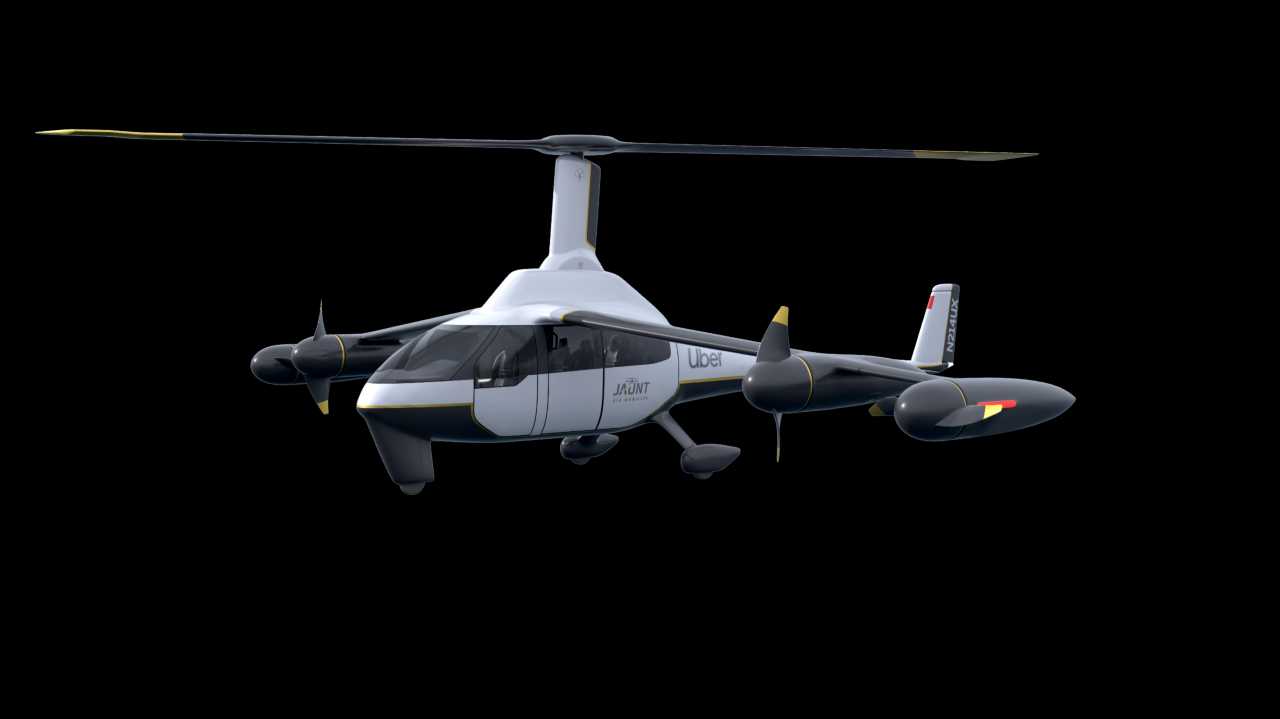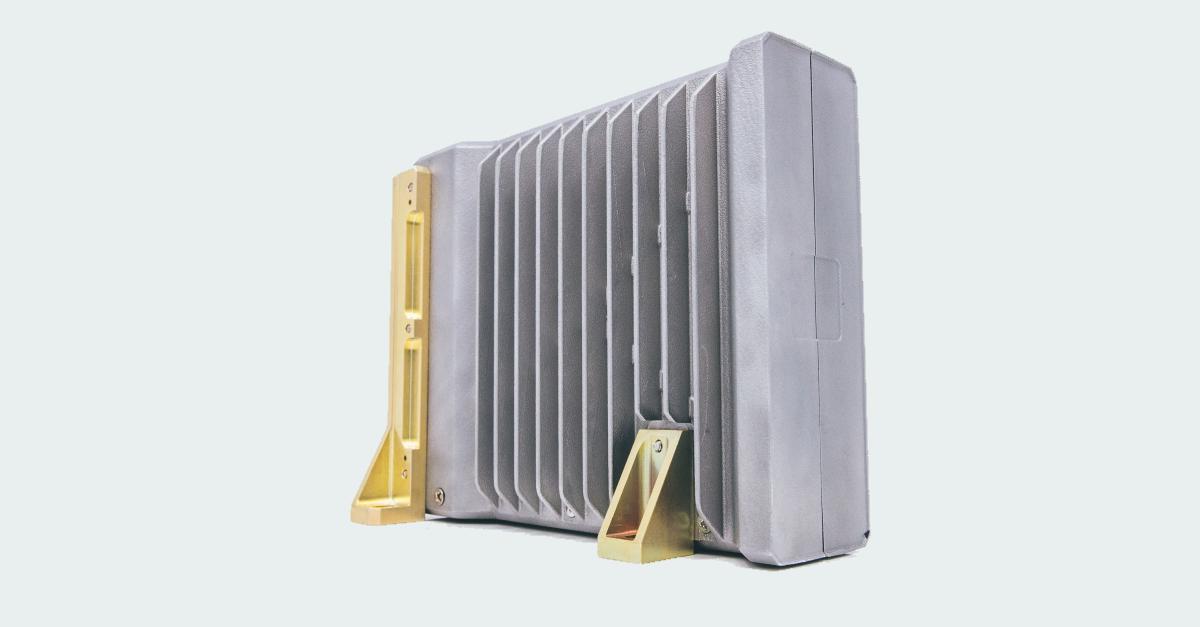
Concept imagery of Jaunt Air Mobility’s UAM vehicle. (Jaunt)
Uber Elevate has named Jaunt Air Mobility its sixth manufacturing partner for urban air mobility (UAM) vehicles.
Joining Bell, Embraer-X, Boeing’s Aurora Flight Sciences, Pipistrel Vertical Solutions and Karem Aircraft, Jaunt is a start-up founded just last year by CEO Kaydon Stanzione. The young company’s vehicle looks like a mash-up of a helicopter and a plane, and Stanzione says it gets the best of both aircraft.
One of Jaunt’s big selling points — and something that really got Uber involved, according to engineering director of aviation Mark Moore — is the proprietary slowed-rotor technology that the start-up is integrating into its vehicle. Acquired from Carter Aviation, the technology is key to enabling lift without the excessive noise that accompanies a traditional helicopter’s rotors.
“It’s one thing to have a great concept,” Moore said. “It’s another thing to own the technology that has been validated. They have all the [intellectual property] ownership of this slowed-rotor technology that lets you get onto wing-borne flight and get off the roadway; that’s theirs. They own it.”
The slowed-rotor technology gives Jaunt’s four wing-mounted propellers an unusual look: They’re curved to maximize surface area without the tip speed exceeding 450 feet per second, Stanzione said. Jaunt’s design also enables reverse-thrust from the propellers and improved low-speed agility.
Uber considers noise one of the major barriers to public acceptance, and Jaunt’s solution mitigates it to a level that is basically imperceptible from the ground, according to Moore.
In addition to the propeller design, that capability is afforded by the fact that the main rotor on top is only used for hover and transition, when the vehicle is far enough off the ground that noise is less of an issue. Lift is provided by the quieter wings. The presence of the top rotor does, however, allow the vehicle to perform a zero roll landing even if all power is out to all the electric motors, Stanzione said, through the use of inertia from the rotor and gliding on the wings.
The other reason that Uber was comfortable taking a chance on such a young company is its partners: Jaunt has agreements in place for tip-to-tail avionics with Honeywell and structures with Triumph Aerospace Structures. The support of established, experienced companies made Uber feel more comfortable that Jaunt knows what it’s doing and is set up for success, while the ability of those companies to do full-suite integration was attractive to Jaunt.
“They have a fully integrated system,” Stanzione said. “The less providers that we can have, the less of an integration problem we’re gonna run into.”
Honeywell, which is also providing UAM avionics for Uber partner Pipistrel and for Eviation, Vertical Aerospace and Volocopter, has adapted navigation systems, radios, collision avoidance, flight management computers displays and other connectivity solutions for the UAM market. The biggest — metaphorically — is its fly-by-wire offering, where the company has shrunk the same system used on Boeing jets to the size of a book.

Honeywell’s fly-by-wire system for the UAM market. (Honeywell)
That’s key; according to Moore, fly-by-wire systems are the enabler for the market. The weight saving afforded by offloading the mechanical components they replace allows an electric vertical-takeoff-and-landing (eVTOL) vehicle to hold the necessary payload to carry passengers, and the automation enabled provides a realistic roadmap to the ultimate goal of unmanned operation. For example, Jaunt’s operator won’t need to separately engage and control the main rotor; the flight control laws — which Jaunt will work on creating now that the news is public — and fly-by-wire system will activate and control the discrete systems as appropriate for what the pilot wants to do.
What Honeywell does for the inside, Triumph does for the outside of the so-called compound aircraft. Triumph is evolving from the manufacture of heavy metals like you might find on the outside of a Boeing jet to thermoplastics, according to Michael Engers, vice president of strategy and business development. Triumph has the ability to scale those moldable thermoplastics, which can meet the needs of the UAM market at a light-enough weight, up into automobile-like production rates at an attractive price point, which is “really exciting” to Uber, according to Moore.
Battery plans aren’t clear yet, but Stanzione said that the company will be working with Honeywell, which just announced a partnership with Japanese automotive manufacturer Denso to develop propulsion systems, and Uber, which poached Tesla’s top battery expert, Celina Mikolajczak, at the start of last year. The battery component of the eVTOL is critical to longevity and cost, so Uber has strict standards to which it is holding its partners.
At a maximum, Uber wants an hourly operating cost of $700 or less, more than one-third less than the cheapest single-engine helicopters. Jaunt doesn’t have a specific number in mind for its vehicle, but Stanzione said the company can hit Uber’s goals.

Want more eVTOL and air taxi news? Sign up for our brand new e-letter, “The Skyport,” where every other week you’ll find the most important analysis and insider scoops from the urban air mobility world.
Jaunt CTO Martin Peryea said the manufacturer is looking at certifying under either Part 27 or Part 29 regulations, both for rotorcraft, indicating that the company expects the finished product to be in the ballpark of 7,000 lbs. — the weight cutoff between those two classes. With an engineering background working on programs such as the 525 at Bell, Peryea has experience with the certification of new aircraft and is working with regulators including the FAA, EASA and Transport Canada to stay on the same page.
Still, Moore expects Jaunt to be a little behind some of Uber’s other partners.
“We anticipate being able to start service with the first handful of aircraft in 2023,” Moore said. “I think Jaunt’s certification will be slightly later than that, we anticipate starting with one or two manufacturers in 2023.”
While Uber currently sits at six partners, don’t expect it to stop there.
Uber envisions itself as an “Amazon-like platform,” in Moore’s words. Rather than “pick winners,” the company “would very much like to be able to employ … any great vehicle that can meet our requirements and satisfy our users’ needs,” he said. That’s especially attractive as the company does not yet know what those users will prefer.
Uber can do surveys — it has done four so far — but it won’t really know what people find most appealing until it has experience. So, the best way to prepare, Moore said. is to have partnerships with a bunch of very diverse vehicles, covering their bases. Until then, that concern is what “keeps up at night.” But if the goal is to diversify the partnership portfolio, bringing in a vehicle as unique as Jaunt’s should be worth a few winks, at least.